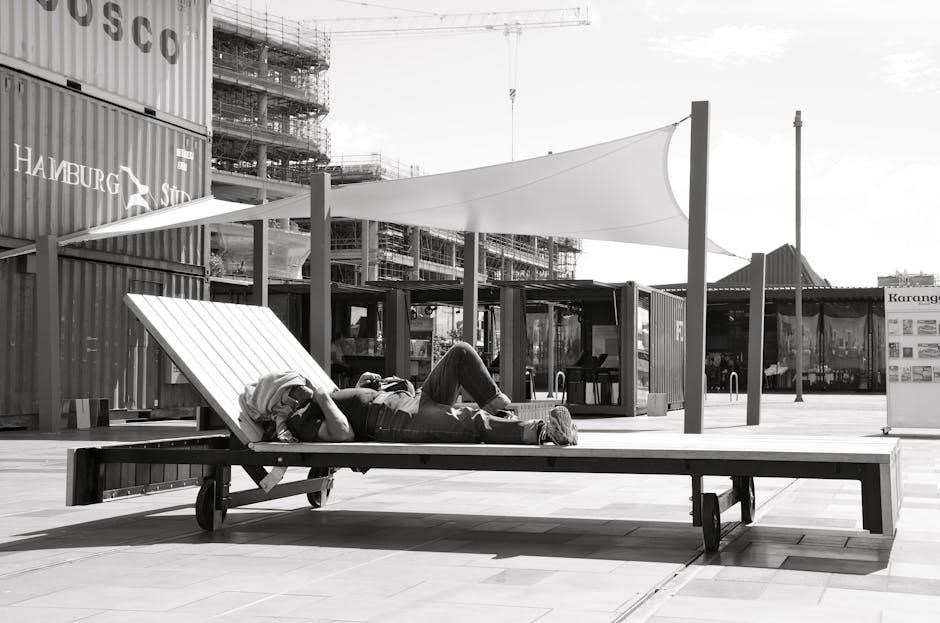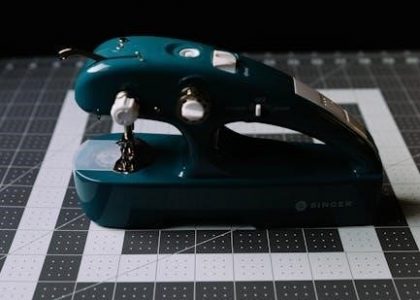Manual reclining offers a personalized relaxation experience, allowing users to adjust their seating position effortlessly. It combines comfort, style, and functionality, making it a must-have for modern living spaces.
1.1. What is Manual Reclining?
Manual reclining refers to a feature in chairs that allows users to adjust their seating position manually, typically using a lever or mechanism to recline the backrest and extend a footrest. This design provides comfort, relaxation, and support, enabling individuals to customize their seating experience. Unlike power recliners, manual models rely on physical effort, often offering a cost-effective and straightforward solution. They are widely used in indoor, outdoor, and multi-functional settings, catering to various lifestyle needs with durable materials and ergonomic designs.
1.2. The History and Evolution of Manual Reclining
Manual reclining has evolved significantly over the years, originating from simple mechanisms to sophisticated designs. Early versions featured basic adjustable backrests, while modern models incorporate advanced ergonomic features. The concept gained popularity in the mid-20th century, with recliners becoming a staple in home furniture. Over time, innovations like adjustable tension, locking systems, and multi-functional designs have enhanced comfort and usability. Today, manual reclining chairs blend tradition with modern technology, offering a perfect balance of style, functionality, and relaxation for diverse lifestyles and preferences.
1.3. Importance of Manual Reclining in Modern Furniture
Manual reclining has become a cornerstone of modern furniture, offering unparalleled comfort and versatility. It cater to diverse lifestyles, providing ergonomic support and customizable relaxation. Whether for indoor lounging, outdoor adventures, or space-saving solutions, manual recliners adapt seamlessly; Their sleek designs and durable materials enhance home aesthetics while ensuring longevity. With features like adjustable footrests and multi-functional mechanisms, they promote physical well-being and mental relaxation. As a result, manual reclining chairs are no longer just furniture but essential elements for modern living, blending practicality with timeless style.

Benefits of Manual Reclining Chairs
Manual reclining chairs offer enhanced comfort, ergonomic support, and versatile relaxation options, promoting physical well-being, mental relaxation, and lifestyle convenience for everyday use.
2.1. Physical Health Benefits
Manual reclining chairs provide exceptional ergonomic support, reducing muscle strain and improving posture. They alleviate back and neck pain by allowing proper spinal alignment. The reclining mechanism helps distribute body weight evenly, preventing pressure points. This feature is particularly beneficial for individuals with chronic pain or mobility issues. Additionally, manual recliners promote blood circulation, which can enhance overall physical comfort and reduce swelling in legs. Regular use can also aid in physical therapy and recovery, making them a practical choice for maintaining long-term physical well-being and health.
2.2. Mental Relaxation and Stress Relief
Manual reclining chairs offer a serene escape from daily stress, promoting mental relaxation and calmness. The gentle motion and customizable positions allow users to unwind, reducing tension and anxiety. By creating a comforting environment, these chairs help lower cortisol levels and improve mood. The quiet, meditative experience of reclining fosters mindfulness, enabling individuals to disconnect from stressors and recharge. Regular use can enhance emotional well-being, providing a peaceful retreat for mental rejuvenation and relaxation in the comfort of one’s own space.
2.3. Lifestyle Convenience
Manual reclining chairs seamlessly integrate into modern lifestyles, offering unmatched convenience. Their easy-to-use mechanisms allow for effortless adjustments, catering to diverse needs throughout the day. Whether for reading, relaxing, or entertaining, these chairs adapt to any setting, enhancing comfort without compromising style. Portability and space-saving designs make them ideal for smaller spaces, while their durability ensures long-term reliability. This blend of practicality and comfort makes manual reclining chairs a versatile addition to everyday life, providing tailored support for various activities and preferences.

Types of Manual Reclining Chairs
Manual reclining chairs come in various types, each designed for specific needs. Indoor chairs offer style, outdoor models durability, multi-functional chairs extra features, and heavy-duty chairs sturdiness.
3.1. Indoor Manual Recliners
Indoor manual recliners are designed for comfort and style within home settings. They often feature ergonomic designs, plush cushioning, and versatile upholstery options to match interior decor. These chairs are lightweight, compact, and perfect for living rooms, reading nooks, or home theaters. Many models offer adjustable headrests and armrests for personalized comfort. They are ideal for daily relaxation, providing a cozy retreat after a long day. Their sleek designs ensure they blend seamlessly with modern or traditional furniture arrangements, making them a practical and aesthetic addition to any indoor space.
3.2. Outdoor and Camping Manual Recliners
Outdoor and camping manual recliners are designed for durability and portability, perfect for nature enthusiasts. These chairs often feature weather-resistant fabric, sturdy frames, and collapsible designs for easy transport. They are lightweight, making them ideal for hiking trips or camping excursions. Many models include adjustable headrests and footrests for comfort in outdoor settings. Their practical design ensures they can withstand rough terrain while providing relaxation. These recliners are a popular choice for campers, offering a balance of practicality and comfort in the great outdoors.
3.3. Multi-Functional Manual Recliners
Multi-functional manual recliners combine comfort with practicality, offering additional features like built-in storage compartments, cup holders, or adjustable trays. Some models include tech integration, such as USB ports or speakers, enhancing convenience. These chairs often serve dual purposes, such as converting into office chairs or incorporating massage functions. Their versatility makes them ideal for small spaces or multi-use areas. With a focus on adaptability, multi-functional manual recliners cater to diverse lifestyles, blending relaxation with everyday utility seamlessly.
3.4. Heavy-Duty Manual Recliners
Heavy-duty manual recliners are designed for durability and stability, often featuring reinforced frames and robust materials to support higher weight capacities. These chairs are ideal for larger individuals or for environments requiring extra sturdiness. They typically include oversized seats, sturdy armrests, and wider bases for enhanced balance. Constructed with heavy-gauge steel and high-density foam, they ensure long-lasting performance. Perfect for both home and commercial use, heavy-duty manual recliners offer comfort and reliability, making them a practical choice for those seeking a resilient seating solution.

Design and Features of Manual Reclining Chairs
Manual reclining chairs blend style and functionality, offering ergonomic designs, adjustable features, and customizable options to enhance comfort and user experience, catering to diverse preferences and needs.
4.1. Stylish and Modern Designs
Manual reclining chairs are crafted with sleek, contemporary aesthetics, blending seamlessly into modern living spaces. Their clean lines, rounded edges, and minimalist profiles create a sophisticated appeal. Available in a variety of colors, patterns, and materials, these chairs can complement both rustic and urban interiors. Many designs incorporate chrome or wood accents, adding a touch of elegance. Lightweight yet durable, they often feature space-saving mechanisms, making them ideal for compact rooms. These chairs are perfect for those who value style without compromising on comfort and functionality.
4.2. Ergonomic Features
Manual reclining chairs are designed with ergonomic precision to ensure optimal comfort and support. Adjustable lumbar support aligns with the natural curve of the spine, reducing strain and promoting proper posture. Padded headrests and contoured seats cradle the body, while extendable footrests allow for full relaxation. Many models feature tension control, enabling users to customize the reclining resistance. These ergonomic elements are tailored to accommodate diverse body types and preferences, making manual recliners a practical choice for long-term comfort and health.
4.3. Customizable Options
Manual reclining chairs often come with customizable options to suit individual preferences. Users can choose from various upholstery fabrics, colors, and patterns to match their home decor. Adjustable armrests and footrest extensions cater to different body sizes and comfort needs. Some models allow for personalized tension settings, enabling users to tailor the reclining mechanism to their liking. Additionally, optional accessories like cup holders or side trays enhance functionality, making these chairs adaptable to diverse lifestyles and requirements while maintaining their core reclining benefits.

Materials and Upholstery for Manual Reclining Chairs
Manual reclining chairs are crafted from durable materials like fabric, leather, and faux leather, ensuring comfort and style. Eco-friendly options are also available, catering to modern preferences.
5.1. Fabric Upholstery
Fabric upholstery is a popular choice for manual reclining chairs, offering softness, breathability, and a wide range of styles. Common fabrics include polyester, microfiber, and linen, providing durability and ease of cleaning. Fabric recliners often feature vibrant patterns and textures, making them versatile for various interiors. They are also lightweight and less formal than leather options, creating a cozy and inviting atmosphere. Additionally, fabric upholstery allows for better airflow, preventing overheating during extended use, and many fabrics are treated with stain-resistant coatings for added practicality.
5.2. Leather Upholstery
Leather upholstery offers a luxurious and durable option for manual reclining chairs, combining timeless style with long-lasting comfort. Genuine leather is prized for its softness and ability to develop a rich patina over time, while faux leather provides a more affordable, low-maintenance alternative. Leather recliners are easy to clean and resistant to spills, making them practical for everyday use. They also exude sophistication, fitting seamlessly into both modern and traditional interiors. Proper conditioning ensures leather remains supple and resistant to cracking, extending its lifespan and maintaining its premium appearance.
5.3. Faux Leather Upholstery
Faux leather upholstery is a popular, cost-effective alternative to genuine leather, offering a similar aesthetic without the higher price. Made from synthetic materials like polyvinyl chloride (PVC) or polyurethane (PU), it is durable, easy to clean, and resistant to stains. Faux leather is lightweight and versatile, making it ideal for manual reclining chairs. It is also cruelty-free, appealing to eco-conscious consumers. While it may lack the natural patina of real leather, faux leather provides a modern, low-maintenance option for those seeking style and functionality in their furniture.
5.4. Eco-Friendly Materials
Eco-friendly materials are increasingly popular in manual reclining chairs, catering to environmentally conscious consumers. These materials include recycled fabrics, organic cotton, and sustainably-sourced wood. They reduce environmental impact while maintaining durability and comfort. Eco-friendly options often feature biodegradable components and non-toxic dyes, aligning with sustainable living practices. This trend reflects a growing demand for furniture that combines style, functionality, and environmental responsibility, making manual reclining chairs more appealing to those prioritizing green living without compromising on quality or aesthetics.

Mechanisms of Manual Reclining
Manual reclining mechanisms rely on levers, springs, and adjustable systems to provide smooth, controlled movement. These components ensure effortless transitions between upright and reclined positions, enhancing comfort and functionality.
6.1. Overview of Manual Reclining Mechanisms
Manual reclining mechanisms are systems that enable chairs to adjust their position through user-operated controls. These mechanisms typically involve levers, springs, and hinges that work together to facilitate smooth transitions between upright and reclined positions. They are designed to provide stability and comfort, allowing users to customize their seating experience. The simplicity of manual systems makes them durable and low-maintenance, ensuring long-lasting performance without the need for external power sources.
6.2. Reclining Lever and Footrest
The reclining lever and footrest are essential components of manual reclining chairs, designed for ease of use and comfort. The lever, often located on the side, allows users to adjust the chair’s position effortlessly. The footrest, which extends as the chair reclines, provides support for the legs. Together, these features ensure a smooth transition between sitting and reclining, enhancing relaxation. The lever’s ergonomic design and the footrest’s sturdy construction contribute to the chair’s overall functionality and user satisfaction.
6.3. Adjustable Tension and Locking Systems
Manual reclining chairs often feature adjustable tension and locking systems for personalized comfort. The tension mechanism allows users to customize the resistance when reclining, ensuring smooth movement. Locking systems secure the chair in desired positions, providing stability and safety. These features enhance usability, allowing individuals to tailor their experience. Adjustable tension caters to different body weights and preferences, while locking systems prevent unwanted shifts, ensuring a secure and enjoyable seating experience tailored to individual needs.

Maintenance and Care Tips
Regular maintenance and care are crucial for longevity. Cleaning, lubricating moving parts, and proper storage ensure your manual recliner remains functional and comfortable over time.
7.1. Cleaning and Upholstery Maintenance
Regular cleaning ensures your manual recliner remains pristine. For fabric upholstery, use a soft cloth with mild soap and water, focusing on stains. Avoid soaking the material. Leather recliners benefit from specialized cleaners and conditioners to prevent cracking. Always test a small area first. For both types, vacuum crevices to remove dust. Damp cloths can wipe down surfaces, but avoid harsh chemicals or abrasive materials. Dry thoroughly to prevent moisture damage. Regular maintenance preserves the appearance and longevity of your recliner.
7.2. Lubricating Moving Parts
Lubricating the moving parts of your manual recliner ensures smooth operation and prevents wear. Use silicone-based sprays or grease on hinges, springs, and mechanisms. Avoid oil-based products, as they may attract dust. Apply lubricant sparingly, wiping off excess with a cloth. Test on a small area first to avoid damage. Regular lubrication, ideally every 6-12 months, keeps the recliner functioning seamlessly. This maintenance step extends the lifespan of the chair and ensures its mechanisms continue to perform optimally. Always follow the manufacturer’s recommendations for lubrication.
7.3. Storage and Protection
Proper storage and protection are essential to maintain your manual recliner’s condition. Before storing, clean the chair thoroughly and use a protective cover to shield it from dust and moisture. Store in a dry, cool place away from direct sunlight to prevent fading. Avoid stacking heavy objects on the recliner to prevent structural damage. If storing for an extended period, consider disassembling parts like the footrest to prevent tension strain. Regularly inspect stored chairs to ensure they remain in good condition. Proper storage extends the chair’s lifespan and keeps it ready for use. Always follow manufacturer guidelines.

Health and Wellness Aspects
Manual reclining chairs promote relaxation, improve posture, and support physical therapy. They enhance sleep quality and provide comfort for individuals with back pain or recovery needs.
8.1. Physical Therapy and Recovery
Manual reclining chairs are beneficial for individuals undergoing physical therapy, offering adjustable support and comfort. They aid in post-surgery recovery by reducing strain on the body. The reclining feature helps improve blood circulation, promoting healing. These chairs also provide the necessary lumbar and leg support, reducing muscle tension. For people with limited mobility, manual recliners enable easy position adjustments, enhancing comfort during recovery. Their ergonomic design supports proper alignment, making them an ideal choice for rehabilitation and post-operative care. Regular use can accelerate recovery and improve overall physical well-being.
8.2. Posture Correction
Manual reclining chairs play a significant role in posture correction by providing optimal support and alignment for the body. Their ergonomic design, including adjustable lumbar support and headrests, helps maintain the natural curve of the spine. By allowing users to recline in a neutral position, these chairs prevent slouching and promote proper spinal alignment. Regular use can improve posture over time, reducing the risk of back and neck pain. The chairs’ ability to adjust to individual needs ensures a comfortable and supportive seating experience, fostering better posture habits.
8.3. Mental Health Benefits
Manual reclining chairs offer significant mental health benefits by creating a calming environment for relaxation. The ability to recline and adjust positions helps reduce stress and anxiety, promoting a sense of comfort and tranquility. The chairs foster mindfulness, encouraging users to focus on their breathing and presence. Improved sleep quality, facilitated by the reclining function, further enhances mental well-being. Additionally, the ergonomic design reduces physical discomfort, which can contribute to irritability and mental fatigue, making manual recliners a valuable tool for mental health care.
8.4. Sleep and Relaxation
Manual reclining chairs are designed to enhance sleep and relaxation by providing optimal comfort and support. The ability to adjust the chair to a perfect reclining position allows for restful napping or overnight sleep. The smooth reclining mechanism ensures minimal disturbance, making it ideal for shared spaces. Additionally, the ergonomic design promotes proper spinal alignment, reducing pressure points and enhancing relaxation. This makes manual reclining chairs a versatile solution for improving sleep quality and creating a calming environment for unwinding after a long day.

Market Trends and Innovations
Manual reclining furniture is experiencing a surge in popularity, driven by demand for ergonomic comfort and smart technology integration. Innovations focus on sustainability and advanced features for enhanced user experience.
9.1. Current Trends in Manual Reclining Furniture
The demand for manual reclining furniture is growing, with consumers prioritizing ergonomic designs and multi-functional features. Space-saving models are gaining popularity, especially in urban settings, while outdoor recliners are being favored for portability and durability. Additionally, there is a rise in smart integration, such as app-controlled adjustments and built-in charging stations. Eco-friendly materials are also trending, as sustainability becomes a key factor in furniture choices. These trends reflect a shift toward comfort, practicality, and environmental consciousness in modern lifestyles.
9.2. Future Innovations in Manual Reclining Technology
Future innovations in manual reclining technology are expected to focus on enhanced smart features and personalized comfort. AI-powered adjustments could automatically adapt to user preferences, while integrated wellness systems might include heating, cooling, and massage functions. Sustainable materials and energy-efficient mechanisms are also anticipated to gain prominence. Additionally, modular designs allowing customization and wireless connectivity for seamless control are likely to redefine manual reclining furniture. These advancements aim to merge technology with tradition, offering users unparalleled convenience and comfort.
9.3. Sustainability in Manual Reclining Chair Production
The shift toward sustainability in manual reclining chair production emphasizes eco-friendly materials and ethical practices. Manufacturers are increasingly using recycled metals, sustainable wood, and organic fabrics to reduce environmental impact. Production processes now focus on minimizing waste and energy consumption. Non-toxic treatments and biodegradable packaging are becoming standard. Many brands are also adopting certifications like FSC and GOTS to ensure compliance with environmental and social standards. This commitment to sustainability not only benefits the planet but also aligns with consumer demands for responsible furniture production.

Frequently Asked Questions
This section addresses common queries about manual reclining chairs, covering features, benefits, maintenance, and troubleshooting to help users make informed decisions and resolve issues effectively.
10.1. How to Choose the Right Manual Recliner
Choosing the right manual recliner involves considering comfort, size, and material. Look for sturdy frames, cushioning, and supportive backrests. Measure your space to ensure a proper fit. Consider fabric or leather upholstery based on durability and style preferences. Test the reclining mechanism for smooth operation and adjustability. Check weight capacity and height settings to suit your needs. Evaluate additional features like footrests or armrests. Read reviews and compare prices to find the best value. Ensure it matches your lifestyle and decor for optimal satisfaction.
10.2. Common Issues and Troubleshooting
Common issues with manual recliners include squeaky frames, stuck mechanisms, or loose parts. For squeaks, apply silicone spray to moving parts. If the recliner doesn’t lock properly, check the mechanism for obstructions and clean it. Loose frames can be tightened by adjusting screws. For creaks, apply wood glue to joints. Regularly lubricate hinges and check for worn-out components. If issues persist, consult a professional. Proper maintenance ensures longevity and smooth operation, keeping your recliner functional and comfortable for years.
10.3. Warranty and After-Sales Service
Most manual recliners come with a warranty covering parts and labor for 1-5 years, depending on the brand. Frame and mechanism warranties are typically longer than upholstery coverage. Extended warranties may be available for additional costs. Manufacturers often provide dedicated customer support for repairs or replacements. Before purchasing, review the warranty terms to understand what is covered. Regular maintenance, as outlined in user manuals, is usually required to maintain warranty validity. Reliable after-sales service ensures peace of mind and extends the chair’s lifespan.
Manual reclining chairs offer unparalleled comfort, versatility, and health benefits. With evolving designs and sustainable practices, they remain a timeless choice for enhancing relaxation and well-being.
11;1. Final Thoughts on Manual Reclining
Manual reclining chairs are a perfect blend of comfort, ergonomics, and style. Their ability to adapt to individual needs makes them a versatile choice for relaxation and health. With advancements in design and materials, these chairs continue to meet modern demands while offering timeless benefits. Whether for daily use or therapeutic purposes, manual reclining chairs remain a practical and enjoyable investment for enhancing overall well-being and creating a cozy living space.
11.2. Customer Reviews and Testimonials
Customers praise manual reclining chairs for their comfort, durability, and value. Many highlight how these chairs improve their relaxation experience, offering excellent support and versatility. Some users appreciate the ease of use and the ability to customize their seating position. Others mention the aesthetic appeal, blending seamlessly with home decor. Overall, positive testimonials emphasize the chairs’ ability to enhance daily comfort and provide long-term satisfaction, making them a worthwhile investment for many households.
11.3. Future of Manual Reclining Technology
The future of manual reclining technology is poised for innovation, with advancements in materials, mechanics, and smart integration. Expect chairs with enhanced ergonomic designs, sustainable materials, and customizable features. Integration with smart home systems could allow for app-controlled adjustments, while advancements in upholstery may include self-cleaning fabrics. Additionally, eco-friendly production methods and energy-efficient mechanisms are likely to dominate. These innovations will continue to prioritize user comfort, durability, and personalization, ensuring manual reclining chairs remain a staple in modern living spaces for years to come.





